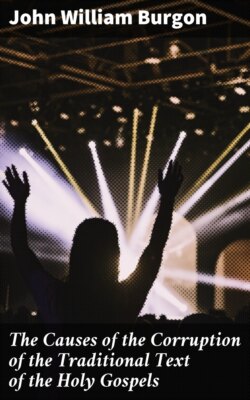Читать книгу The Causes of the Corruption of the Traditional Text of the Holy Gospels - John William Burgon - Страница 32
На сайте Литреса книга снята с продажи.
§ 4.
ОглавлениеTable of Contents
The termination ΤΟ (in certain tenses of the verb), when followed by the neuter article, naturally leads to confusion; sometimes to uncertainty. In St. John v. 4 for instance, where we read in our copies και εταρασσε το 'υδωρ, but so many MSS. read εταρασσετο, that it becomes a perplexing question which reading to follow. The sense in either case is excellent: the only difference being whether the Evangelist actually says that the Angel 'troubled' the water, or leaves it to be inferred from the circumstance that after the Angel had descended, straightway the water 'was troubled.'
The question becomes less difficult of decision when (as in St. Luke vii. 21) we have to decide between two expressions εχαρισατο βλεπειν (which is the reading of [Symbol: Aleph]*ABDEG and 11 other uncials) and εχαρισατο το βλεπειν which is only supported by [Symbol: Aleph]bELVA. The bulk of the Cursives faithfully maintain the former reading, and merge the article in the verb.
Akin to the foregoing are all those instances—and they are literally without number—, where the proximity of a like ending has been the fruitful cause of error. Let me explain: for this is a matter which cannot be too thoroughly apprehended.
Such a collection of words as the following two instances exhibit will shew my meaning.
In the expression εσθητα λαμπραν ανεπεμψεν (St. Luke xxiii. 11), we are not surprised to find the first syllable of the verb (αν) absorbed by the last syllable of the immediately preceding λαμπραν. Accordingly, [Symbol: Aleph]LR supported by one copy of the Old Latin and a single cursive MS. concur in displaying επεμψεν in this place.
The letters ΝΑΙΚΩΝΑΙΚΑΙ in the expression (St. Luke xxiii. 27) γυναικων 'αι και were safe to produce confusion. The first of these three words could of course take care of itself. (Though D, with some of the Versions, make it into γυναικες.) Not so however what follows. ABCDLX and the Old Latin (except c) drop the και: [Symbol: Aleph] and C drop the αι. The truth rests with the fourteen remaining uncials and with the cursives.
Thus also the reading εν ολη τη Γαλιλαια (B) in St. Matt. iv. 23, (adopted by Lachmann, Tischendorf, Tregelles, Alford, Westcott and Hort and the Revisers,) is due simply to the reduplication on the part of some inattentive scribe of the last two letters of the immediately preceding word—περιηγεν. The received reading of the place is the correct one—και περιηγεν 'ολην την Γαλιλαιαν 'ο Ιησους, because the first five words are so exhibited in all the Copies except B[Symbol: Aleph]C; and those three MSS. are observed to differ as usual from one another—which ought to be deemed fatal to their evidence. Thus,
B reads και περιηγεν εν 'οληι τηι Γαλιλαιαι. [Symbol: Aleph] reads και περιηγεν 'ο ις εν τηι Γαλιλαιαι. C reads και περιηγεν 'ο ις εν 'ολη τηι Γαλιλαιαι.
But—(I shall be asked)—what about the position of the Sacred Name? How comes it to pass that 'ο Ιησους, which comes after Γαλιλαιαν in almost every other known copy, should come after περιηγεν in three of these venerable authorities (in D as well as in [Symbol: Aleph] and C), and in the Latin, Peshitto, Lewis, and Harkleian? Tischendorf, Alford, Westcott and Hort and the Revisers at all events (who simply follow B in leaving out 'ο Ιησους altogether) will not ask me this question: but a thoughtful inquirer is sure to ask it.
The phrase (I reply) is derived by [Symbol: Aleph]CD from the twin place in St. Matthew (ix. 35) which in all the MSS. begins και περιηγεν 'ο ις. So familiar had this order of the words become, that the scribe of [Symbol: Aleph], (a circumstance by the way of which Tischendorf takes no notice,) has even introduced the expression into St. Mark vi. 6—the parallel place in the second Gospel—where 'ο ις clearly has no business. I enter into these minute details because only in this way is the subject before us to be thoroughly understood. This is another instance where 'the Old Uncials' shew their text to be corrupt; so for assurance in respect of accuracy of detail we must resort to the Cursive Copies.
